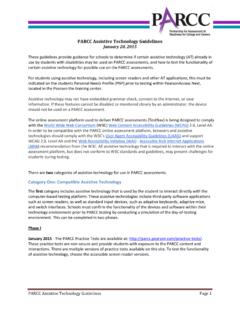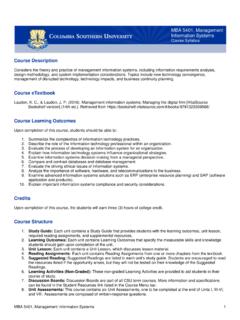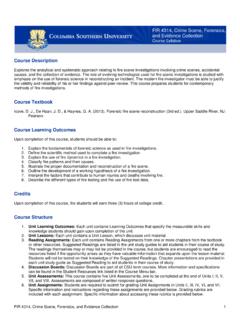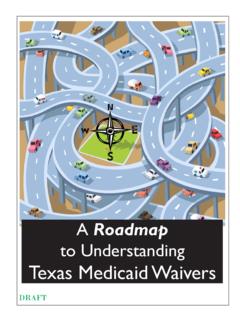Transcription of PCAT Basics: Purpose, Structure, and Administration
1 PCAT basics : purpose , structure , and Administration Effective: July 2016 Copyright 2004, 2008, 2012, 2014, 2015, 2016 NCS Pearson, Inc. Warning: No part of this publication may be reproduced or transmitted in any form or by any means, electronic or mechanical, including photocopy, recording, or any information storage and retrieval system, without the express written permission of the copyright owner. Pearson, PCAT, and the PCAT logo are trademarks in the and/or other countries of Pearson Education, Inc., or its affiliates. NCS Pearson, Inc., 5601 Green Valley Drive, Bloomington, MN 55437 Produced in the United States of America.
2 Product Number 65694 PCAT 1-800-622-3231 PCAT basics iiiCopyright 2016 NCS Pearson, Inc. All rights reserved. Table of Contents Acknowledgments .. iv Introduction .. 1 Pearson .. 1 American Association of Colleges of Pharmacy .. 1 History of the PCAT .. 2 Test structure .. 3 PCAT Content Areas .. 3 Test Administration .. 10 Registration and Scheduling .. 10 Test Administration .. 10 Score Reporting .. 11 Personal Official Score Reports .. 12 Official Transcripts .. 13 Transcript Service .. 15 Glossary .. 16 References .. 17 Figures 1 PCAT Subtests .. 4 2 PCAT Writing Subtest Blueprint .. 4 3 PCAT Biological Processes Subtest Blueprint.
3 5 4 PCAT Chemical Processes Subtest Blueprint .. 6 5 PCAT Critical Reading Subtest Blueprint .. 7 6 PCAT Quantitative Reasoning Subtest Blueprint .. 8 7 Sample Official Score Report .. 12 8 Sample Official Transcript .. 14 1-800-622-3231 PCAT basics ivCopyright 2016 NCS Pearson, Inc. All rights reserved. Acknowledgments This document was prepared by the following members of the Pearson Clinical Assessment group: Donald G. Meagher, EdD Senior Research Director Tianshu Pan, PhD Psychometrician Rachel Wegner, MA Test Development Manager Jeffrey R. Miller, MA Editor 1-800-622-3231 PCAT basics 1 Copyright 2016 NCS Pearson, Inc.
4 All rights reserved. Introduction The Pharmacy College Admission Test (PCAT ) is a norm-referenced standardized test that is developed to measure the abilities, aptitudes, and skills that pharmacy schools deem essential for success in their programs. In an effort to ensure the continuing relevance and usefulness of the PCAT for assessing the prerequisite knowledge and skills of candidates for admission to professional pharmacy programs, the test content is periodically reviewed and revised to ensure that it accurately reflects current pharmacy school prerequisite requirements in the sciences, math, and language arts. This publicly available document provides information about PCAT history, content, structure , Administration , and score reporting.
5 The following additional publications are also available on the PCAT website: Interpreting PCAT Scores, with information useful in interpreting all PCAT scaled scores, percentile ranks, and Writing scores; and PCAT Reliability and Validity, with information and research results related to the reliability and validity of the test. Also available only to qualified professionals is the printed PCAT Technical Manual (Pearson, 2016), which contains detailed data for the current normative sample, the current 2015 percentile ranks, compendium tables that can be used to compare the previous 2011 percentile ranks with the current percentile ranks, and a table showing differences in Composite percentile rank between those with and without the Verbal Ability subtest.
6 To request a copy of the PCAT Technical Manual, or to offer suggestions regarding the PCAT or about this or any other related publications, please contact PCAT Customer Relations at the following email address: Pearson Pearson develops and publishes tests for college admission and business, as well as materials for service providers in education, clinical psychology, speech and language, and occupational therapy. Its staff includes professionals in testing and measurement, specialized support personnel for test production and design, editorial assistance, and data analysis services. A specialized team within the Pearson Clinical Assessment group is responsible for the development, Administration , and monitoring of the PCAT.
7 American Association of Colleges of Pharmacy The American Association of Colleges of Pharmacy (AACP) was founded in 1900 and is the primary national organization representing the interests of pharmaceutical education and educators. Based in Washington, , the AACP is composed of all colleges and schools of pharmacy accredited by the Accreditation Council for Pharmacy Education. The AACP includes approximately 6,400 full-time faculty, 62,500 professional degree students, and 5,100 individuals pursuing graduate study (American Association of Colleges of Pharmacy, 2015). The AACP and its members are committed to maintaining excellence in pharmaceutical education and to helping member schools prepare well-qualified graduates for entrance into the profession of pharmacy.
8 The PCAT Advisory Committee of the AACP has worked closely with Pearson (formerly The Psychological 1-800-622-3231 PCAT basics 2 Copyright 2016 NCS Pearson, Inc. All rights reserved. Corporation) for many years to monitor annual PCAT score data and to suggest periodic improvements to the test to ensure that it continues to reflect changes in pharmacy school prerequisite requirements and curricula. History of the PCAT In 1973, the AACP conducted a study of pharmacy school admissions processes. The results of the study indicated that most colleges of pharmacy established their own admissions policy and basic requirements and then selected from students who met those requirements.
9 At that time, 82% of the colleges of pharmacy expressed interest in having an admissions test specific to pharmaceutical education. Based on this response, the AACP concluded that a national exam would be beneficial in providing a source of data on student placement and retention. The AACP then established the PCAT Advisory Committee to work with The Psychological Corporation (now Pearson) to develop a norm-referenced standardized test. Following experimental administrations in 1973, the first PCAT norms were established, and the PCAT was administered for admissions purposes to more than 1,600 applicants in the fall of 1974. Over the ensuing years, periodic revisions have been made to the contents and structure of the test.
10 In 1999, the PCAT Advisory Committee requested a revision of the PCAT test blueprint to reflect changing prerequisites of pharmacy schools. Because several pharmacy schools had developed their own essay assessments, the Advisory Committee also suggested that an essay component be added to ensure that standardized Administration , scoring, and reporting processes were followed. In response to these needs, new test forms were developed and an essay component was field-tested and then introduced in 2005 as an operational component of the test. Following ongoing discussions with the PCAT Advisory Committee, changes to the Quantitative Ability subtest were introduced in 2007 to include items on basic math (replacing geometry items) and a greater proportion of probability/statistics and pre-calculus items.








